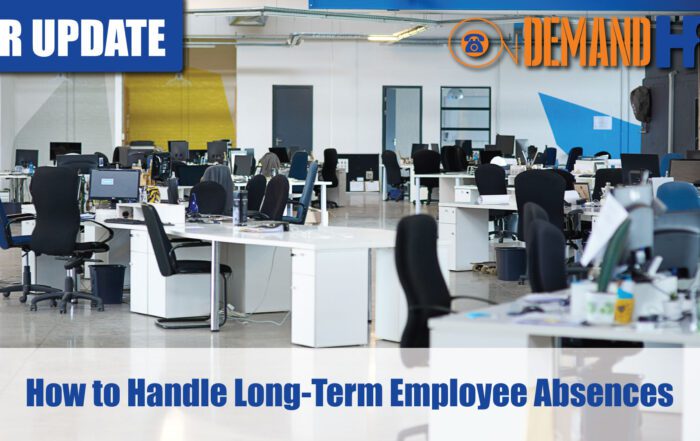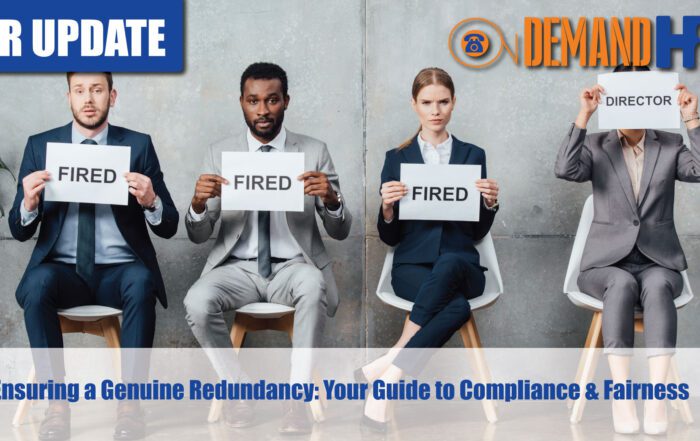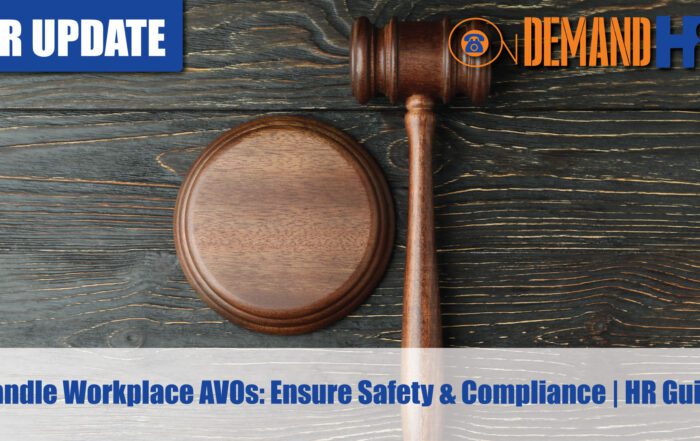Policies & Procedures
In episode 12 of HR Fridays Clint breaks down the policies and procedures you should be including in your manuals but also what you should be including to avoid creating additional obligations on your business.
Please see below for a full transcript of the video
Share the HR or workplace relations challenge facing your business and one of our experienced consultants will be in touch within 24 hours with a strategic action plan or discover the best strategy yourself by accessing out free online training library.
Transcript
0:14
Ladies and gentlemen, good morning Welcome to another HR Fridays with On Demand HR. My name is Clint Indrele Managing Director of On Demand HR. As you are very well aware every week we have a specific topic at 11:30 on Fridays, where we talk about something in the workplace relations HR, recruitment space all the other potential matters before the Fair Work Commission. Please let us know any topics of interest or future topics of interest, please let us know any comments you’ve got throughout today’s presentation happy to take questions on the fly and answer them as we can. The whole purpose of HR Fridays is to try and provide businesses, professional advisors and our associate members advice, which is based on reality. We have been in the Fiar Work Commission many times we’ve conducted many workplace investigations, we’ve dealt with the Fair Work Ombudsman a number of times and other employment tribunals. And we can provide you with real perspective on these issues, not just theory and scare tactics that you may often get from other advisors, please visit www.ondemandhr.com.au for a full comprehensive suite of our services, first of all, but also plenty of education tools there for you to look at also.
1:33
Today’s topic is going to be policies and procedures, the do’s and the don’ts of policies and procedures. So most organizations have them, but how effective are they at actually delivering what the business should have in these areas. So without further ado, let’s get into today’s presentation.
1:54
So first and foremost, to give you an overview of the types of policies and procedures that we would normally recommend to a small to medium business. This is just an example of some of the policies that we would we would look at and draft for your organization. So first of all, we draft provisions in relation to meals and breaks. We draft provisions in relation to things like you know, grooming and hygiene, secondary employment that could also be a contractual matter out of hours conduct is a very important one, people often do not understand that their employment may be subject to things that happen outside of work. So there’s been many cases where employees have unfortunately engaged in behavior outside of work, which is then inconsistent with their employment continuing from that point forward, obviously, a very high bar. But nonetheless, something that does come up. Leave policies we often have in there around requesting, taking leave those sorts of things, email and internet usage, what employees are allowed and not allowed to do. Personal phones, fitness for work. working from home is a new policy area that we’ve been developing over the past few years. So having clean procedures around what is expected in a working from home environment. This can also include checklists and things like that, that employees are required to fill out when assessing their home workspace. We have counseling and disciplinary policies, but we’ll talk about that a little bit later. Because that’s actually a really interesting topic and one that needs to be taken with great caution. We might have policies around timesheets, social media use another great one another topical one, what employees should or should not post on social media, at work or outside of work. The outside of work part of it in particular being very important. Many situations where employees have been terminated because of behavior outside of work in respect to social media. Workplace surveillance can often be important when you are using video surveillance, there are requirements in each state with respect to the relevant acts and how video surveillance can be used. So that’s a very important one. Confidentiality that may be dealt with in the contract may not necessarily always be in policy manual, Company vehicles, workplace discrimination, harassment and bullying, very important to have those policies in your employee handbook, grievances and problem resolution also extremely important. So those two, those last two work hand in hand, to identify what those issues are, and then have a mechanism to deal with those issues. Work, health and safety, reporting and consultation are two important ones to have in the manual. Social distancing is another new one that we’ve included for the purposes of you know, COVID-19 and making sure that businesses with employees at the office or otherwise have those measures clearly understood and identified. We then usually have policies around absences and how absences should be dealt with particularly unexpected absences. And then finally punctuality and overtime are also things that we can deal with in an employee handbook. So typically these are common, let’s say 20 or so policies that we have. And what we really try and do in these policy manuals is focus on the policies being as simple as possible. And we’ll get into in a moment, I guess what a good policy manual should have. And then we’ll talk about some things that a policy manual shouldn’t have, or common mistakes that we see in policy manuals.
5:29
So first and foremost, a policy manual should be simple, easy to understand, and something that will be actually read by employees. I often see policy manuals written in a very strong, and legal jargon language. And I really, I don’t necessarily agree that that is the best way of communicating a policy, I think there’s got to be somewhere in between the policy being well written, but also being understandable and put in layman’s terms. So I don’t think it’s the same sort of language that you would have in a policy manual, or sorry, in a in a contract of employment. I think it’s somewhere between that sort of style of language and putting it into terms that are kind of layman’s terms for employees to understand. So that’s the first thing I would say about policy manuals, keeping them simple, keeping them as short as possible and having them easy to understand. A policy manual should ideally deal with standards of performance, behavior and conduct of employees and policies should be designed to create obligations on employees. What we often see and we will talk about this in the next slide is policies being overwritten, and organizations getting carried away with writing motherhood statements, which create unnecessary obligations on the organization. So the important thing the policy manual should create expectations and obligations on employees in respect to performance, behavior and conduct. A policy manual should also deal with key compliance things such as policies around any discrimination, harassment, and bullying, you must define what these things are for a variety of reasons, workers comp claims, for general complaints, and also to ensure that your organization is not exposed in respect to, you know, future claims that could be brought in these areas, you must also have a grievance procedure to deal with anti discrimination, harassment, and bullying and other potential general complaints that may arise, you must deal with things like video surveillance, if you are carrying out video surveillance of work sites where employees may be present. And also there’s other compliance things such as WHS consultation, there is probably a few more that were in that list that we spoke about earlier. But to give you a flavor of, I guess, some of the compliance style policies, those are some examples of things that should be included. I guess another thing is to understand that really what we should be having in an employment contract, and an employee policy manual should not really overlap too much. The employment contract should really define the terms and conditions or the expressed terms and conditions of the employment or the legal terms conditions of the employment. The policy manual should be something that changes over time and evolves, as the expectations of performance, behavior and conduct also evolve. So there should be very much viewed as two separate things, you will have, you know, some crossover in some areas. But ultimately, it should deal with things that aren’t necessarily dealt with in the employment contract, particularly in relation to performance, behavior and conduct. And again, your policies can be amended from time to time as your business expectations change. And the idea of having this sitting outside of the employment contract is that these changes can be made without necessarily obtaining mutual agreement with employees.
9:03
So we’ll move on to some of the don’ts or some of the things and problems we see in you know, the manual and and these sorts of things that organizations often get wrong. So I think the general rule when looking at policy mistakes is anything that creates unnecessary obligations on the organization. If you’re creating an unnecessary obligation on the organization, it’s probably not a great idea to put it into a policy manual. The main areas that I see this when we assess policy manuals are in disciplinary policies. This is a fundamental error that is made very, very often we see disciplinary policies which prescribe that the employee will be given this warning, this warning and this warning, this is what the warning will say this is the period of time that the employee will be given to improve and so on and so forth. Whilst that might sound like a very noble gesture and might sound like, you know, ideally how we’d like to run this process. In practicality, these sorts of policies can be a disaster, especially when you need to expedite a performance process or a conduct process in respect to potentially terminating employment sooner than would otherwise be prescribed in the policy. So what you want in the policy is flexibility to be able to deal with issues on their merits. And I certainly would not be going into detail about how many employee warnings someone is going to receive prior to termination. The Fair Work Act in Section 387 makes it clear. In terms of unfair dismissal considerations, the commission will consider how many warnings that have been given to an employee when considering whether or not a termination is valid, why as an organization, you need to do anything beyond defining how many warnings are appropriate is beyond me. And I see it very often. And in my opinion, it is a massive mistake when those sorts of policies are written in that way. So something to be very careful of, if you are preparing a disciplinary policy. In terms of grievance and investigation policies, I see similar mistakes in these policies as well. So being too prescriptive about how an investigation will be conducted, what sort of you know, how the employee will be given the right to respond, obviously, an employee will give you will be given a right to respond. But we see policies that are written that the employee will be given, you know, X amount of time to respond, and they will have the opportunity to provide this response in writing and after the response is provided in writing, they’ll then come to a meeting, and then the meeting will be conducted in this particular way. The problem with again, policies like that is that, you know, each investigation is different, they may be conducted differently. And, again, trying to lock yourself into very stringent rules around these things is not a good idea. Certainly you can refer to the prospect of an investigation being conducted. But I would be very hesitant to create specific rules around how investigation should be conducted, and so on. So again, I’ve seen many, many situations where the policy ultimately brings the business or organization into criticism when it’s conducted an investigation, which is appropriate for the circumstances, but doesn’t follow the policy that has been written. So again, I would avoid being too prescriptive on policies such as this performance review policies is another one committing or saying that the organization will do a performance review every three months or six months, or whatever it may be unnecessary. Again, organizations reserve the right to review the performance of their employees at any time, you don’t need to have a policy statement saying that you can do that or to give you the right to do that. And again, if you do not conduct performance reviews every three months or six months, as you say, then ultimately, you end up in a circumstance where employment has been terminated, well, then you’ve got the scenario where you can be criticized for not reviewing a person’s performance on as regular basis as you identify that you would. So again, with performance review policies, very loose, I would be having just general guidelines around how these things might be conducted, and not committing to how often these things will necessarily be conducted as well. I guess the other comment more generally, is other overly detailed and complicated policies, when you write your policies, and when you’re thinking about or writing any statements in there about what the organization might do, be very careful committing to things that you first of all, may not do, or second of all, are unnecessary. And as a general rule, avoid anything that’s unnecessary. And don’t over commit to anything that the organization can’t clearly deliver on or hasn’t been delivering on. And again, we often see policies that are out of step with the current custom practice that we see in the organization. So again, I’d be looking at that in a variety of other policy areas.
14:13
So look, if you’ve got any final questions about this, please shoot them through, we will wrap up this presentation on policies and procedures in a moment. So I’d like to sort of just go through again, a quick summary of what we’ve covered today. And essentially, from a policies and procedures perspective, I’d be looking at focusing on generally a core of around about 20 policies, I’d be keeping these policies to half a page to a page, you know, not having four page five page policy documents that inevitably won’t be read and inevitably are probably too prescriptive for your organization. So that’s the first comment I would make, you know, 20 to 25 key policies, the list we outlined a pretty good starting point. Looking at certainly keeping them simple in simple language if possible, and, and looking again at trying to avoid unnecessary obligations for your organization, making sure they reflect the practices of your organization as it currently stands. So thanks very much once again for tuning in. My name is Clinton Indrele, Managing Director of On Demand HR. You’ll see us again once again next Friday for another edition of HR Fridays. We’ll release our topic earlier in the week on Facebook and on LinkedIn. So have a wonderful weekend everyone. If you’ve got any final questions, please put them in the comments tab and we can return back to you at the appropriate time. Thanks again and have a wonderful weekend.






